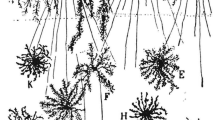Summary
A new Orange G-fluorescence method (Zimmermann, 1967) is applied to the nervous system ofLumbricus terrestris L. for demonstration of fibrous neuroglia cells. The seven different types of these cells reveal a high degree of differentiation and a specific pattern of regional distribution. The processes of the fibrous neuroglia cells form basketlike structures on the surface of neurosecretory cells. The glia fibers are composed of fine filaments (approximately 50 Å thick). After unilateral cauterizing of the supraesophageal ganglion (brain) or lesions put in the ventral nerve cord the damaged tissue is restored within 15 days after the injury (regeneration phases I–III). The regeneration of the neurosecretory system shows a distinct morphological pattern. The replacement of the neurosecretory cells anteceds the restitution of the fibrous neuroglia. In the surrounding intact areas of the nervous system an activation of neurosecretory cells occurs. The matrix of the newly formed glial elements is of ectodermal origin. The development of very obvious complexes formed by neurons and glial satellites was traced by means of fluorescence microscopy. The functional significance of these findings has been discussed.
Zusammenfassung
Mit einer neuen Orange G-Fluoreszenzmethode (Zimmermann, 1967) können im Zentralnervensystem vonLumbricus terrestris L. sieben verschieden differenzierte Fasergliatypen nachgewiesen werden. Die Verteilung dieser Zellen weist regionale Unterschiede auf. Fortsätze der Faserglia umhüllen korbartig auch die neurosekretorischen Ganglienzellen. Die einzelnen Gliafasern sind aus etwa 50 Å starken Filamenten aufgebaut. Nach unilateraler Läsion des Oberschlundganglions oder Verletzung des Bauchmarks wird das zerstörte Gewebe bis zum 15. Tag nach dem Eingriff in drei Phasen regeneriert. Dabei werden die neurosekretorischen Zellen in einer bestimmten Reihenfolge früher restituiert als die Faserglia. Gleichzeitig ist in den benachbarten intakten Regionen eine Aktivierung der neurosekretorischen Reservezellen zu erkennen. Die neugebildeten Fasergliaelemente gehen aus neurektodermalen Matrixzellen hervor. Dabei werden charakteristische Nervenzell-Fasergliakomplexe ausgebildet. Die funktionelle Bedeutung dieser Befunde wird diskutiert.
Similar content being viewed by others
Literatur
Aros, B., andB. Vigh: Neurosecretion as a holocrine gland function in Lumbricidae. Acta. biol. Acad. Sci. hung.13, 177 (1962).
Bullock, T. H., andG. H. Horridge: Structure and function in the nervous systems of invertebrates, vol. I–II (annelida byT. H. Bullock, vol. I, p. 661–790). San Francisco and London: W. H. Freeman & Co. 1965.
Cajal, S. R.: Neuroglia y neurofibrillas delLumbricus. Trab. Lab. Inv. Biol. Madr.3, 277–285 (1904).
Fawcett, D. W.: The cell. Philadelphia and London: W. B. Saunders 1966.
Fleischhauer, K.: Fluoreszenzmikroskopische Untersuchungen an der Faserglia. Z. Zellforsch.51, 467–496 (1960).
Gabe, M.: Neurosecretion in invertebrates. In: Neurosecretion. Internat. series of monographs on pure and applied biology, division zoology28, part II, sect. I (1966).
Gersch, M.: Vergleichende Endocrinologie der wirbellosen Tiere. Leipzig: Akademische Verlagsgesellschaft 1964.
Harms, W. J.: Über ein inkretorisches Cerebralorgan bei Lumbriciden sowie Beschreibung eines verwandten Organs bei drei neuenLycastis Arten. Arch. Entwickl.-Mech. Org.143, 332–346 (1948).
Havet, J.: Contribution à l'étude de la névroglie des invertébrés. Trab. Lab. Inv. Biol. Madr.14, 35–85 (1916).
Herlant-Meewis, H.: Croissance et reproduction du LombricienEisenia foetida. Ann. Soc. roy. zool. Belg.85, 119–151 (1954).
—: Neurosécrétion chez les Oligochètes. Bull. Acad. Belg., Cl. Sci. V,41, 500–506 (1955).
—: Les hormons chez les invertébrés. Mouvement Sci. Belg.7, 3–14 (1962a).
—: Neurosecretory phenomena during regeneration of nervous centres inEisenia foetida. Neurosecretion. Memoirs of the Society for Endocrinology, No.12, p. 267–274. London and New York: Academic Press 1962b.
—: Les cellules neurosécrétices de la chaine nerveuse d'Eisenia foetida. Z. Zellforsch.69, 319–325 (1966).
—, andJ. Delique: Influence of the nervous system on regeneration in annelids, p. 228–239, Proc. regeneration in animals. Amsterdam: North. Holl. Publ. Co. 1965.
Hubl, H.: Die inkretorischen Zellelemente im Gehirn der Lumbriciden. Arch. Entwickl. Mech. Org.146, 421–437 (1953).
—: Über die Beziehung der Neurosekretion zum Regenerationsgeschehen bei Lumbriciden nebst Beschreibung eines neuartigen neurosekretorischen Zelltyps im Unterschlundganglion. Arch. Entwickl.-Mech. Org.149, 73–87 (1956).
Knowles, F. G. W.: The structure of neurosecretory systems in invertebrates. In: Comparative endocrinology (eds.U. S. von Euler andH. Heller), vol. II, p. 47–62. New York and London: Academic Press 1963.
Kuffler, S. W., andJ. G. Nicholls: The physiology of neuroglial cells. Ergebn. Physiol.57, 1–90 (1966).
Oksche, A.: Die praenatale und vergleichende Entwicklungsgeschichte der Neuroglia. Acta neuropath. (im Druck).
— u.D. S. Farner: Das räumliche Bild des neurosekretorischen Systems der Vögel unter normalen und experimentellen Bedingungen. Z. Zellforsch.64, 83–100 (1964).
Otremba, P.: Beobachtungen an neurosekretorischen Zellen des Regenwurms (Lumbricus spec.). Z. Zellforsch.54, 421–436 (1961).
Scharrer, E.: The capillary bed of the central nervous system of certain invertebrates. Biol. Bull.87, 52–58 (1948).
—, andB. Brown: Neurosecretion XII. The formation of neurosecretory granules in the earthworm,Lumbricus terrestris L. Z. Zellforsch.54, 530–540 (1961).
—, andB. Scharrer: Hormones produced by neurosecretory cells. Recent Progr. Hormone Res.10, 183–232 (1954a).
— —: Neurosekretion. In: Handbuch der mikroskopischen Anatomie des Menschen (Hrsg.W. Bargmann), Teil 5, S. 953–1047. Berlin-Göttingen-Heidelberg: Springer 1954b.
Sterba, G., u.G. Hoheisel: Darstellung des neurosekretorischen Systems der Insekten mit Pseudoisocyanin. Z. mikr.-anat. Forsch.72, 31–48 (1964).
Zimmermann, P.: Methodische Modifikationen und eine neue Technik zur Darstellung des neurosekretorischen Apparates und der Neuroglia bei Wirbellosen (Lumbricus terrestris L.). Z. wiss. Mikr. (im Druck).
Author information
Authors and Affiliations
Additional information
Frau Professor Dr.Berta Scharrer gewidmet.
Teil einer medizinischen Doktorarbeit.
Mit Unterstützung durch die Deutsche Forschungsgemeinschaft.
Rights and permissions
About this article
Cite this article
Zimmermann, P. Fluoreszenzmikroskopische Studien über die Verteilung und Regeneration der Faserglia beiLumbricus terrestris L.. Z.Zellforsch 81, 190–220 (1967). https://doi.org/10.1007/BF02075970
Received:
Issue Date:
DOI: https://doi.org/10.1007/BF02075970




